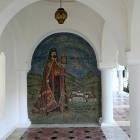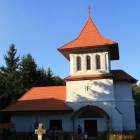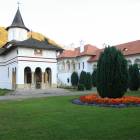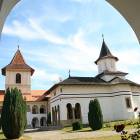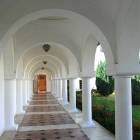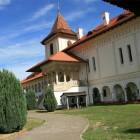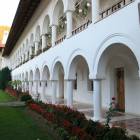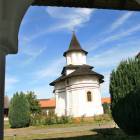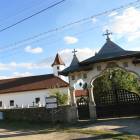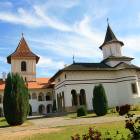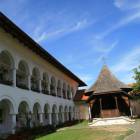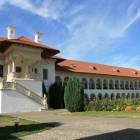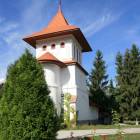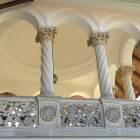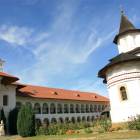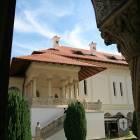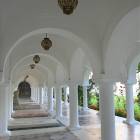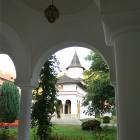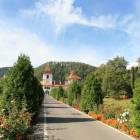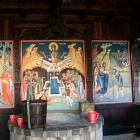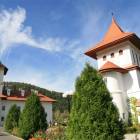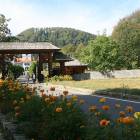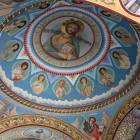The blessed place of Sâmbăta de Sus Monastery
Surrounded by the highest peaks in Romania (the Făgăraș Mountains, part of the Carpathian chain), this monastery assures you that God can be found where is beauty. The beauty of the natural surroundings and the spiritual tradition of Sâmbăta de Sus work together to create one of the most special places you will ever encounter. It is so close to the busy towns of Transylvania and yet so deep in another world, which makes you feel lucky for discovering it.
The closest town is Făgăraș, less than 20 km away. But other major cities are not far away either: Sibiu (65 km), Brașov (80 km), or the capital Bucharest (265 km). The national road DN 1, from Făgăraș to Sibiu, is in very good shape and you only need to take left after the village Voila, towards Sâmbăta de Sus, on an also well maintained road.
The first you will encounter is the village of Sâmbăta de Sus, where there is also a large supermarket for last minute shopping. Don’t mistake the village church, located near the cemetery, with the destination of our journey. That little building, named the Eastern Church is just a parish church used by the locals. For Constantin Brâncoveanu monastery you need to continue on the same road for another 3 km. There is almost no chance of getting lost here, just follow the main road, and you will get there.
The scenery that opens after abandoning DN1 speedy road is impressive. The mountains create a natural amphitheater, visible from afar, across an endless plane. Depending on the season of your arrival, the plane may be all green or yellow, while the mountains might be covered in snow or completely green. Somewhere over the visible peaks, there should be Moldoveanu Peak (2,544 m), the highest point in Romania. The surrounding mountains are massive, so it might be possible you lose GSM signal, when climbing inside this arch, but it shouldn’t be a problem for newer telephones.
The monastery is right at the beginning of the mountain hills, so you won’t get to much of a higher altitude by car. Regardless of that, the gigantic forests around can make the temperatures drop during the night. A walk in the fir forests of some 50 m high, along the pure and fresh waters of a noisy spring, can prove a marvelous experience. Somewhere higher in the mountain there are the caves and shelters once used by lonely hermits that are now legends. And also in these forests, for almost 15 years, groups of armed Romanians resisted the communist regime, that took power with the Russian occupation, after the second world war.
The monastery of Sâmbăta maintains untouched both the Byzantine orthodox tradition and the natural landscape. The interior alleys are surrounded by lawn and flowers, while the large sculpted gate is more for decorative purpose than for keeping the visitors out. The name of the monastery comes from a Romanian prince, Constantin Brâncoveanu, who was turned into a martyr by the Turks for not abdicating his faith. He was not only important for his legendary execution in Constantinople, but also for the development of an artistic style during his reign, equivalent to a Romanian Renaissance. The architectural style of Brâncoveanu blends together folkloric motifs and Romantic elements, with rounded arches and braided columns. The style has become the norm for churches in the south of the country and is also employed by major palaces. Under the vaults of the cells there is a bust and a symbolic tomb of Constantin Brâncoveanu and actual tombs of other personalities, like bishop Arsenie Plămădeală. The palace prepared by Brâncoveanu as a retirement place for him and his family can still be seen, newly restored, in the village.
The place suffered terrible persecutions, especially during the occupation of Transylvania by the Austrian Hungarian Empire. Then it was destroyed using canons at the order of an Austrian general, for not renouncing the Orthodox faith to turn to Catholicism. The monastery of Brâncoveanu, created in 17 century, was rebuilt in the beginning of the 20th century, under king Michael, the last Romanian monarch, whose portrait is right next to the entrance. Like all monasteries of Brâncoveanu, built south of Carpathians, Sâmbăta also became a cultural center, with workshops for painting, printing house with intense translation and writing program, that attracted resentment from Catholic and Calvinist authorities that held the power in Transylvania before the Romanian Unification in 1918.
The most famous monk of this place was Arsenie Boca, who lived somewhere higher in the mountain and is considered a saint by many, due to his numerous attested miracles. Also some other confessors lived here, including Teofil Pârâian, a charismatic blind monk, that became known nation wide for his sermons.
The liturgies held in the small church of the monastery are amazing to witness and the monks are also available for private talks on spiritual matters. The monastery of Sâmbăta de Sus is also an important Orthodox cultural place. There is a museum inside the cells and an outer building named the Academy of Sâmbăta de Sus, where conferences and lectures are held constantly. Also, the large store of the monastery has an offer of great works of art crafted locally. From here you can buy authentic Byzantine style icons of all sizes, painted by monks of this or other monasteries with art workshops.
Inside the walls of the monastery there is a small roof covering the Healing Spring, near which the monastery was built in the time of Brâncoveanu.
In recent years the place has become more popular, and as a consequence the guest houses are more numerous each year, with accommodation possibilities of all sorts, from camping to hotel standards. The monastery itself has an office where you can book a room in one of the cells, for a real monastery experience.
Mai multe despre: Religious architecture, Romania • Brancovenesc style • Constantin Brancoveanu • Fagaras • monastery • Orthodox church • Romania • Romanian architecture • Transylvania- Home Page
start page - Architecture
landmark buildings - Sacred architecture
places of worship - Nature
landscape photography - Concert
performing artists - Christmas
Santa Claus pictures
- Jooble
jobs for photographers - Escape
an out of control blog - Merry Christmas
The best organizer of Christmas parties - Astro photo
Eclipse hunting and astrological photography


